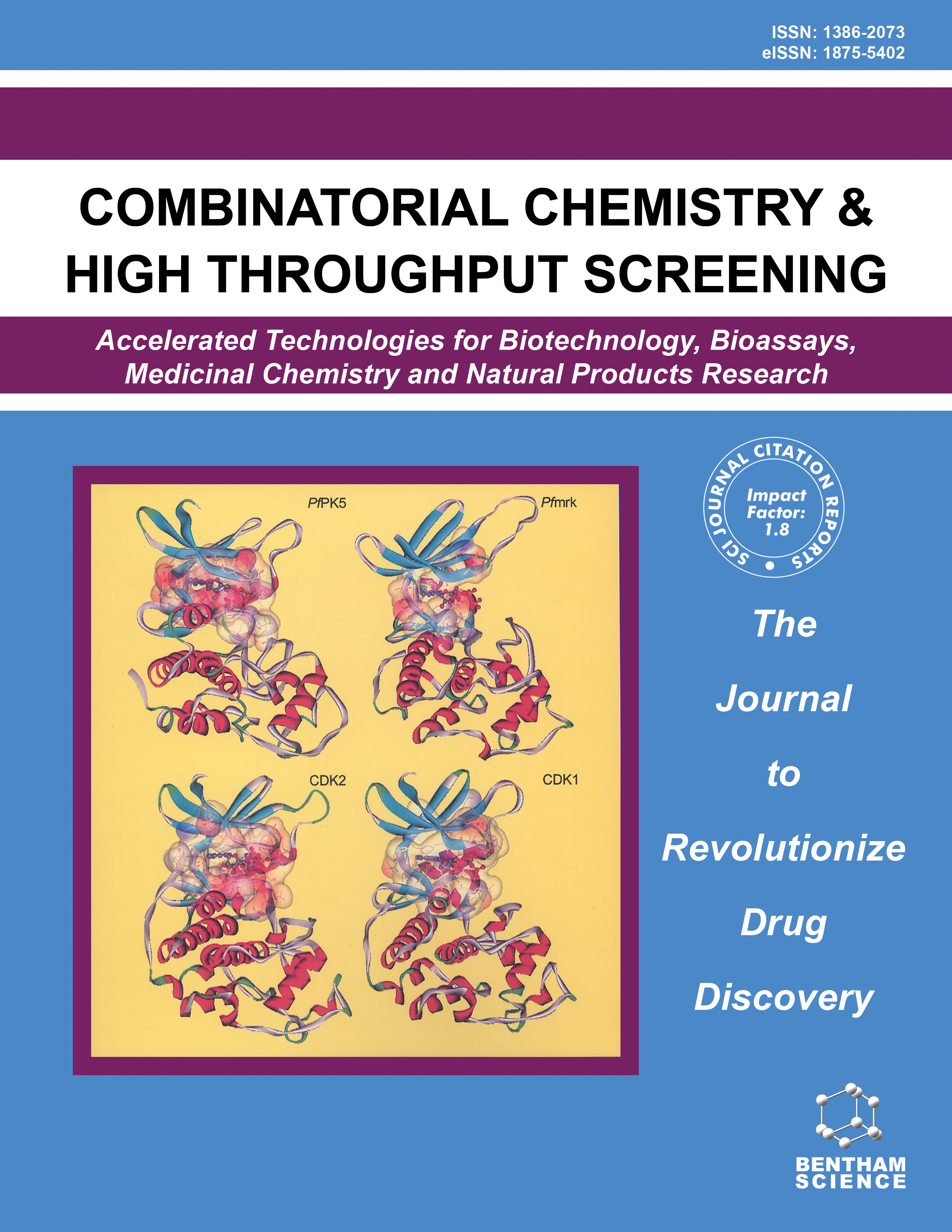- Home
- A-Z Publications
- Combinatorial Chemistry & High Throughput Screening
- Previous Issues
- Volume 14, Issue 4, 2011
Combinatorial Chemistry & High Throughput Screening - Volume 14, Issue 4, 2011
Volume 14, Issue 4, 2011
-
-
Fabricating Gradient Hydrogel Scaffolds for 3D Cell Culture
More LessAuthors: Kaushik Chatterjee, Marian F. Young and Carl G. SimonOptimizing cell-material interactions is critical for maximizing regeneration in tissue engineering. Combinatorial and high-throughput (CHT) methods can be used to systematically screen tissue scaffolds to identify optimal biomaterial properties. Previous CHT platforms in tissue engineering have involved a two-dimensional (2D) cell culture format where cells were cultured on material surfaces. However, these platforms are inade Read More
-
-
-
Procaine Effect on Human Erythrocyte Membrane Explored by Atomic Force Microscopy
More LessThe procaine effect on human erythrocytes was investigated by atomic force microscopy (AFM) at three procaine concentrations, about 5 x 10-7 M, 5 x 10-5 M and 5 x 10-4 M. The changes in surface morphology of erythrocyte membrane bring direct evidence on the procaine effect on the cell membrane at micro- and nanometer scale. AFM images of the control erythrocytes (without procaine) showed a well defined concave ( Read More
-
-
-
Two Panels of Steroid Receptor Luciferase Reporter Cell Lines for Compound Profiling
More LessAuthors: David Sedlak, Aileen Paguio and Petr BartunekSteroid hormone receptors represent a major target in drug discovery. As ligand inducible transcription factors, their activity can be modulated by small lipophilic molecules. Here we describe two panels of potent and selective luciferase reporter cell lines based on cells with low endogenous steroid receptor activity (U2OS). The panels contain reporter cell lines for estrogen receptors α and β, androgen, glucocorticoid, mineral Read More
-
-
-
Novel Affinity Ligands for Chromatography Using Combinatorial Chemistry
More LessSpatially addressable combinatorial libraries were synthesized by solution phase chemistry and screened for binding to human serum albumin. Members of arylidene diamide libraries were among the best hits found, having submicromolar binding affinities. The results were analyzed by the frequency with which particular substituents appeared among the most potent compounds. After immobilization of the ligands either thr Read More
-
-
-
Chemistry Explained by Topology: An Alternative Approach
More LessAuthors: Jorge Galvez, Vincent M. Villar, Maria Galvez-Llompart and Jose M. AmigoMolecular topology can be considered an application of graph theory in which the molecular structure is characterized through a set of graph-theoretical descriptors called topological indices. Molecular topology has found applications in many different fields, particularly in biology, chemistry, and pharmacology. The first topological index was introduced by H. Wiener in 1947 [1]. Although its very first application was Read More
-
-
-
Recent Advances on Potentiometric Membrane Sensors for Pharmaceutical Analysis
More LessAuthors: Vinod K. Gupta, Arunima Nayak, Shilpi Agarwal and Barkha SinghalPrime concerns with modern developments are attributed to high level undetected but important biological substances or even toxicants cycled often among individual and populations; which in turn agonizes environmental monitoring, trace-gas detection, water treatment facilities, in vivo detection in biological fluids and other accomplishments. For the detection of such analytes, several analytical devices combined with bi Read More
-
-
-
Patent Review
More LessBy Anuradha RoyThe section on patent review will be focused in the areas of interest to the readers of CCHTS. The search was conducted using the following key words: combinatorial chemistry, high throughput screening, drug repurposing, chemical library, high content screening, drug discovery and natural products. All patents highlighted here are identified by the patent number issued either by the World Intellectual Property Organization o Read More
-
Volumes & issues
-
Volume 28 (2025)
-
Volume 27 (2024)
-
Volume 26 (2023)
-
Volume 25 (2022)
-
Volume 24 (2021)
-
Volume 23 (2020)
-
Volume 22 (2019)
-
Volume 21 (2018)
-
Volume 20 (2017)
-
Volume 19 (2016)
-
Volume 18 (2015)
-
Volume 17 (2014)
-
Volume 16 (2013)
-
Volume 15 (2012)
-
Volume 14 (2011)
-
Volume 13 (2010)
-
Volume 12 (2009)
-
Volume 11 (2008)
-
Volume 10 (2007)
-
Volume 9 (2006)
-
Volume 8 (2005)
-
Volume 7 (2004)
-
Volume 6 (2003)
-
Volume 5 (2002)
-
Volume 4 (2001)
-
Volume 3 (2000)
Most Read This Month
Article
content/journals/cchts
Journal
10
5
false
en

Most Cited Most Cited RSS feed
-
-
Label-Free Detection of Biomolecular Interactions Using BioLayer Interferometry for Kinetic Characterization
Authors: Joy Concepcion, Krista Witte, Charles Wartchow, Sae Choo, Danfeng Yao, Henrik Persson, Jing Wei, Pu Li, Bettina Heidecker, Weilei Ma, Ram Varma, Lian-She Zhao, Donald Perillat, Greg Carricato, Michael Recknor, Kevin Du, Huddee Ho, Tim Ellis, Juan Gamez, Michael Howes, Janette Phi-Wilson, Scott Lockard, Robert Zuk and Hong Tan
-
-
- More Less

